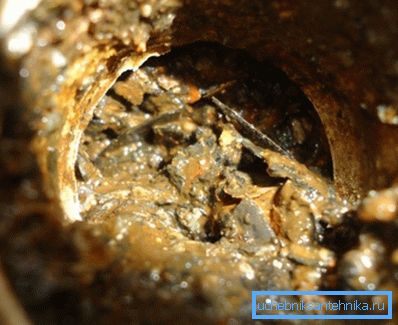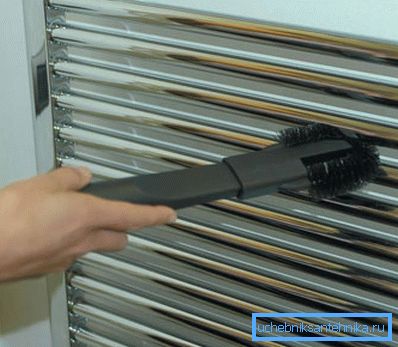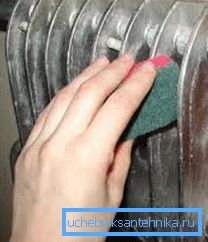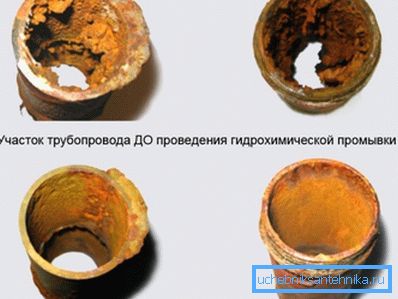How to clean the radiator: the method of processing inside
Probably, any good owner knows how to clean the radiators outside and inside, and also understands that this should be done regularly. Not only the appearance and efficiency of work, but also the service life of products depend on the condition of the surfaces of heating devices, since the absence of prophylaxis is one of the best incentives for the development of corrosion.
In our article we will give an algorithm of actions, following which you can keep the heating system of your house or apartment clean.

Why clean up
To begin, let us see how important the care of the surface of the battery and the state of its "entrails".
If we turn to specialists, we will find out that cleaning performs a number of important functions to neutralize negative impacts:

- First, the dust, glowing between the sections, acts as a heat insulator, reducing the efficiency of heat transfer.
- Secondly, on the surface of the product a fatty film is formed sooner or later., which also disrupts heat transfer.
Note! These two factors are extremely relevant for products with convection fins: debris clogging in the gaps between the plates of heat exchangers, "steals" a significant part of the energy and also causes the battery to overheat, reducing its life.

- Third, rust and salt deposits are heating up inside the radiator.. Partially they settle in the lower part, blocking the normal flow of water, partially - they are fixed on the walls, forming a dense deposit with high thermal insulation characteristics.
- In addition, among the internal deposits there is a large proportion of particles with abrasive properties.. These particles have a negative impact on the operation of valves, disabling sealing gaskets and metal parts.
As you can see, the lack of timely cleaning can lead to a number of negative consequences. That is why the instruction recommends paying close attention to regular prevention.
Processing technique
Outside
External treatment of radiators is a rather simple and easy task. In principle, in order to maintain the system in good condition, it is enough to go through each radiator with a vacuum cleaner during the cleaning process, and then treat the surface with a damp cloth with a non-aggressive detergent.
However, if there are difficulties with cleaning or it is necessary to restore the working condition of a sufficiently old heater, then we act as follows:
- If the design of the device provides such an opportunity, dismantle the protective shields, the walls of the case and the grating in the upper and lower parts of the product. As a rule, it is here that the bulk of the dust accumulates.

- We clean these parts under running water using a sponge or scraper if necessary. After cleaning, dry them thoroughly.
- The radiator itself is vacuumed, removing large accumulations of dust with a brush.
- Wipe all surfaces with a damp sponge, trying not to leave stains.
Tip! When cleaning copper pipes and heat exchangers, it is undesirable to clean the patina, as it protects the metal surface from further oxidation and corrosion.

In principle, more is not required: the main thing is not to start the situation until the formation of a dense dust “felt” between the heat transfer plates.
Inside
However, putting the battery in order outside is not even half the battle. Much more difficult to perform internal cleaning. Most often, to solve this problem, experts are attracted with fairly complex equipment, or they flush the entire heating system at home at a time, but if you wish, you can do it yourself.

We need to act this way:
- Shut off valves, blocking the flow of coolant to the radiator.
- Turn off the nuts that the battery is attached to the pipes of the heating network.
- Carefully drain the remaining water from the tanks.
- We remove the battery from the mountings and remove it from the room, since the internal cleaning almost always involves the appearance of a large amount of dirt.
Tip! If you live in a private house, then all activities are best carried out on the street, near the drain hole. In the apartment, you will have to use the bathroom, covering it with a thick cloth to avoid damage to the enamel and installing a protective mesh on the drain hole to trap solid particles.
Hose flushing procedure
The cleaning itself is carried out as follows:
- We take a mallet (it can be replaced with an ordinary hammer and a wooden bar) and carefully knock all sections of the radiator. Such an impact will accelerate the detachment of plaque and rust from the walls.
- We lean the radiator on its side, shake it thoroughly and pour large solid particles out of the drain hole.
- Then we pour hot water into the radiator tanks and make up for about 20-30 minutes.
- After that, with the help of a shower or a hose, we perform washing, treating the internal surfaces until clean water comes out of the drain hole.
The use of special formulations

Sometimes this treatment is not enough - water just does not cope with perennial deposits on the walls of batteries.
In this case, you have to use chemicals:
- In the water for washing add soda, serum or citric acid. Influencing plaque, they contribute to its decomposition and detachment, shortening the cleaning process.
- You can also use special acid-base compositions, which are much better than whey or citric acid, destroy oxides and salt deposits. Of course, the cost of such funds is quite high, but if we consider that processing is not often required, then these expenses can be fully afforded.

- Before you clean the aluminum radiator, you need to carefully examine the composition of the flushing fluid. The fact is that alkali reacts with aluminum, and therefore there is a risk not only to clean the walls of the product, but also to damage them. So for this purpose it is best to either take specialized formulations, or dispense with gentle methods.
Conclusion
It will be useful for everyone to understand how to clean heating radiators from dust and how to remove salt deposits and rust inside the batteries. Having studied the method of preventive treatment (the video in this article will help with this) and effectively applying our knowledge, we will provide the heating system of our house with a long service life with high productivity.